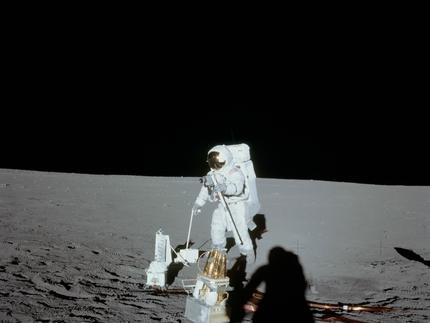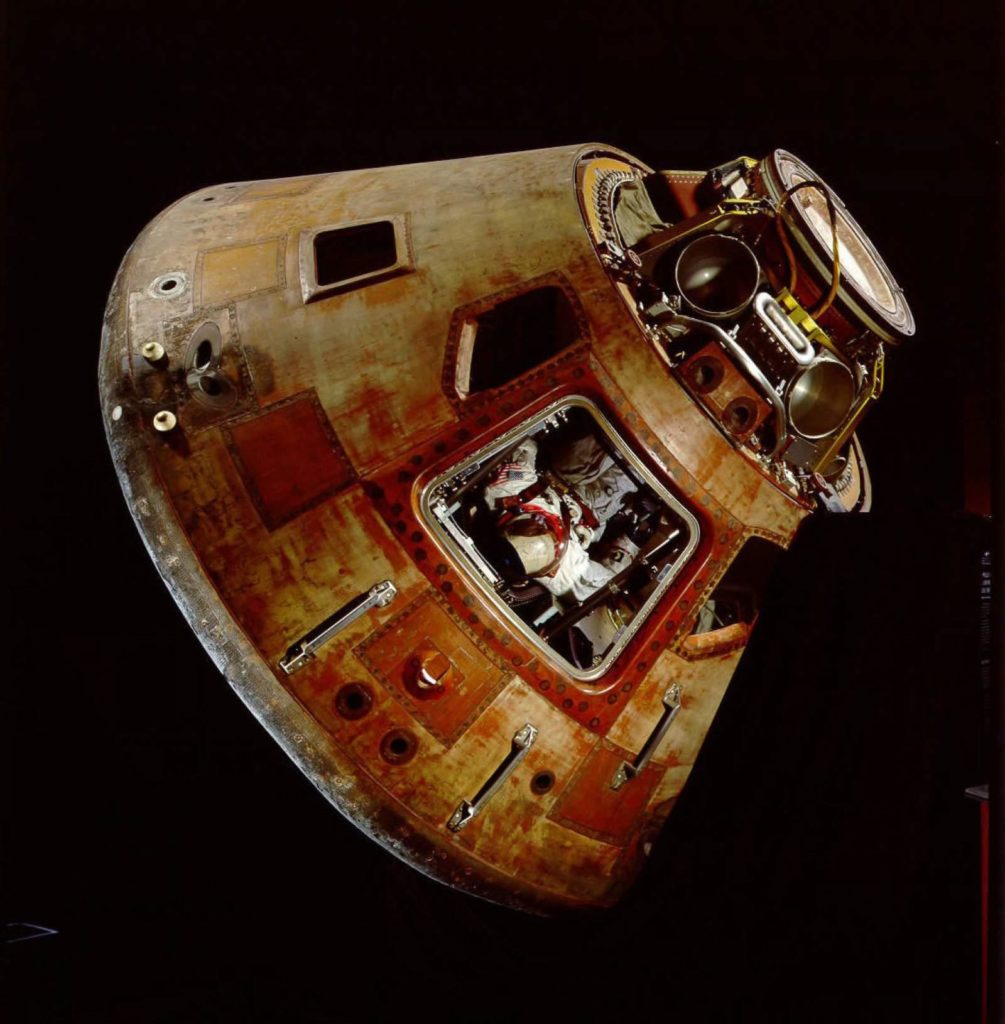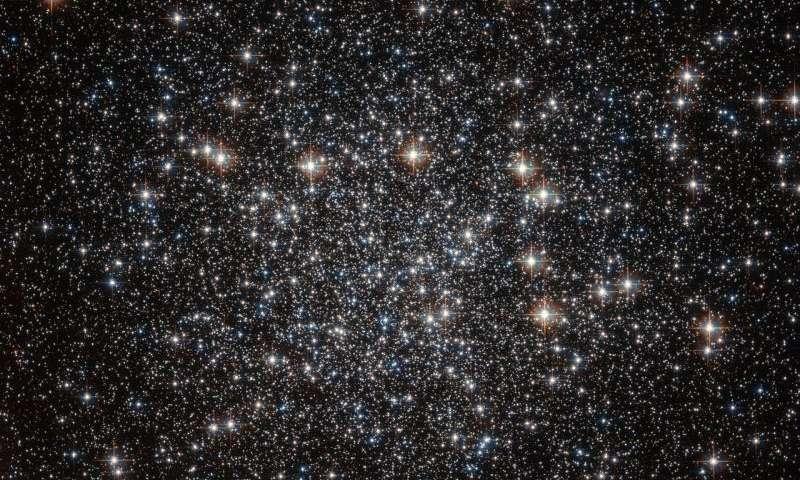How High the Moon? Or the Greatest Deception of Them All…
Emanuel E. Garcia | NEXUS Magazine – TRANSCEND Media Service
“Fake news” is nothing new. In less glamorous times, perhaps, it was known as subterfuge, lying, deceit, deception, advertising or public relations. One of the advantages of aging is that one may look back and, in so looking back, events which, at the time of perception, seemed perfectly plausible, can be peered at more closely and, can, in fact, be seen for what they really were.
Thus Pearl Harbor, the dropping of the atomic bombs on Hiroshima and Nagasaki, the Gulf of Tonkin ‘incident’ that launched the Vietnamese debacle, and, more recently, the ostensible discover of Iraq’s ‘weapons of mass destruction’ — all of these events, considered in the reflective hindsight of reason, have been exposed.
We now know that the Japanese attack on Pearl Harbor was, at the very least, a provocation; that the unleashing of nuclear weapons upon Japan was strategically unnecessary; that the Gulf of Tonkin events were a lie and, of course, that Colin Powell’s ‘proof’ to the United Nations that Saddam Hussein po... was false.
Lies of course have consequences and governments employ them to serve various interests of State: all governments lie, needless to say, to serve themselves. Indeed a complete catalogue of governmental deceptions would be virtually immeasurable: it may be far more fruitful to ask when these entities actually tell the truth. And even then, one should be sceptical: for truth, like Scripture, may be a devil’s tool as well: “for oftentimes to win us to our harm the instruments of darkness tell us truths, win us with honest trifles, to betrays in deepest consequence” as Banquo tells Macbeth (Act I, Scene 3).
In casting my eye over the vast array of State deceptions during my own lifetime, from JFK’s assassination by a lone rifleman to the implosion of World Trade Tower 7 from office fires on 9/11, I had never thought to question the Apollo moon missions. These achievements, after all, represented humankind at its best: the striving for and reaching a goal that had hitherto been thought impossible.
The landing of a man on our moon was, we were told, something that transcended nationalism: although carried out by the United States, it unified all of our fragile species for several glorious years.
The Apollo missions occurred at a time when the United States was deeply at war, both hot and cold, and in the aftermath of a series of political assassinations, civil rights marches and student revolt. They were, as I remember them, the bright and shining examples of America’s masterfully benevolent exceptionalism, a kind of salve for the wounds we had inflicted, a beacon to our shuddering masses in the midst of strife. To doubt them – as a few cranks I knew at the time insisted on doing – was as absurd as doubting apple pie. Or so I thought.
History, in the decades since I was a teenager and now, has intervened, and I suppose that the weight of so many duplicitous occurrences has led me to cast an eye on what I had hitherto thought to be unassailably true. In so doing I have been led to the conclusion that this giant leap for mankind was the greatest deception of them all.
It wasn’t a cover-up, it didn’t hide a crime, it wasn’t a provocation used to justify another egregious assault somewhere far away. It was a masterstroke of propaganda, a masterpiece of psychological persuasion whose radiant glow continues to this day. How could a State capable of such powerful magnificence be so tawdry, bellicose and relentlessly destructive? Impossible – unless one is willing to face the very heart of the evil of power.
I write therefore not to persuade but to invite my readers, however few, to question, to bear with me as I raise my own questions. There are so many improbabilities in the sequences that led to the Apollo moon landings that I can hardly do them justice: others have delineated and described them well, and they include the absence of a stepwise testing protocol, numerous photographic anomalies, and the lack of any independent verification of NASA’s claims. Rather than attempt to manage this morass I will instead direct you to a compact handful of works which I believe are worth investigating (appended), but in passing I will mention a few of the anomalies that caught my reflective eye: the absence of dust on the landing pads of the lunar module, the lack of a crater underneath the LEM (Lunar Excursion Module) which would have been formed by the rockets thrusting for descent, and the repetition of identical background images in ostensibly different lunar locations.
Furthermore, as a reasonably thoughtful person, I will ask you to consider the following major issues.
- Why hasn’t NASA or anyone else for that matter returned a human being to the lunar surface since 1972?
- Could the astronauts’ space suits have protected them from the severe fluctuation of temperatures on the lunar surface (a 500 degree Fahrenheit swing from above boiling point in the sun to far below freezing in the shade)? Could they have protected them sufficiently from cosmic radiation and the dangers of micrometeorites?
- Could the photographic film in the famous Hasselblad cameras used to take the iconic lunar photos have survived the radiation of space?
- Could the Command Module’s heat-shield have effectively prevented the craft from melting during re-entry into the atmosphere of Earth at speeds of 40,000 kmh?
- Why are there no recent photos in fine resolution of the relics of the Apollo missions left on the lunar surface?
- Where are the stars?
NASA’s Right of Return
Given the wonderfully successful lunar landings of twelve astronauts during the Apollo missions, one would expect that returning to the moon would be a cinch for the agency that orchestrated the accomplishments in an era of relatively low computational technology.
Not so, apparently. Incredibly enough NASA astronaut Don Pettit asserts that NASA destroyed the technology used during the Apollo missions and that “it’s a painful process to build it back again.”
NASA engineer Kelly Smith, when speaking of the Orion program, asserts that the problems of radiation have to be solved before we can send people into deep space beyond low earth orbit.
For the definitive treatment of these baffling matters, please see New Zealander Phil Kouts’ most recent article.
NASA is having so much trouble getting ‘back’ to the moon simply because they never got there in the first place, and the obstacles posed by sending and returning a human being into deep space beyond low earth orbit have not yet been overcome.
Space Suits: the International Latex Corporation
For astronauts to survive on the lunar surface during their extravehicular forays, they needed to be encased in spacesuits that would offer protection from severe temperatures, the radiation of space, and the danger posed by micrometeorites which would have been fatal if they created even a miniscule tear in the fabric of the suits.
Were their spacesuits and life support systems capable of these objectives? NASA of course claims yes, as they would, and the ILC contends that their suits did all that was required, though others have raised doubts, particularly with respect to radiation. I for one am flabbergasted to have seen the Apollo astronauts frolicking on the ostensible lunar surface with such abandon, knowing that a gash or tear into their garments would mean virtually instant death.
Dave McGowan has his own take on what he dubs the ‘magic suits’:
The Apollo spacesuits supposedly weighed in at 180 pounds each, including the PLSS backpacks. You would think that with the advanced technology now available, NASA would have been able to streamline the package. To the contrary, the suits now worn aboard the space shuttle weigh in at 310 pounds each. And ILC claims that it takes three months and 5,000 man-hours to produce each one. Back in the ‘60s, they claimed to be cranking out a minimum of nine of them for each Apollo flight. (Wagging the Moondoggie, Part 9)
You be the judge.
The Magic Kodak Film
Apollo astronauts were outfitted with a modified Hasselblad 500 EL camera. It had no viewfinder and it housed a 70 mm thin emulsion Kodak film. It had no radiation protection.
How can film subjected to cosmic and galactic radiation on the lunar surface be unaffected, when radiation at 240 miles above the earth resulted in fogging or clouding?
Re-entering the Atmosphere at 40,000 km/h: the Command Module Heat Shield
The angle of the Command Module upon re-entering the Earth’s atmosphere had to be perfect for the craft’s ablative thermal shield to absorb the immense heat and allow the vehicle eventually to splash down safely into the ocean. Curiously enough, for its new Orion program, NASA is having problems reproducing Apollo’s success in protecting the spacecraft during re-entry. As Phil Kouts writes:
“The importance of a totally reliable and effective heat shield cannot be overstated. The availability of a proper heat shield was absolutely critical for the safe return of all the Apollo crews. NASA’s admission that the agency cannot now recreate the thermal shield of a return module is absolutely astounding. Such an admission could only be compared to an inconceivable statement that, for example, American military officials admit that after using armoured steel in their tanks during WWII, some 40 years later they don’t have the technology at hand to develop armoured steel, and have great difficulty in reproducing such steel despite the previous experience during the war. The GAO report concludes: ‘With respect to Orion’s thermal protection system, facilities available from the Apollo era for testing large-scale heat shields no longer exist.’ (GAO, 2008 p.14)”
Unless the Command Module were encased in its entirety by a thermally resistant shell that could withstand the searing heat of re-entry – up to 5,000 degrees Fahrenheit – it would simply have melted as it was engulfed by the flames engendered by its penetration of the atmosphere. Bear in mind that re-entry from low earth orbit, as accomplished by the Space Shuttle, is a different matter altogether, with significantly lower speeds and temperatures.
Independent Photographic Evidence of the Lunar Landings
In John Noble Wilford’s book We Reach the Moon (1973), he writes that that the Lunar Orbiters of the 1960s which preceded the Apollo missions were equipped with a high resolution lens (Eastman Kodak) that could pick out details “as small as the top of a card table.”
If that was the case, why then haven’t succeeding orbiters like Selene and the Lunar Reconnaissance Orbiter achieved resolution fine enough to show clearly evidence of the landings?
And to carry this point further, if earth-orbiting satellites at very high distances can achieve very fine detail, e.g., enough to show individual cars, etc., why don’t the lunar photographic satellites, closer to their target and moving more slowly, achieve at least the same?
The Stars That Didn’t Shine in the Night
Like the famous dog that didn’t bark in Conan Doyle’s Sherlock Holmes story Silver Blaze, during the Apollo missions stars apparently didn’t shine. In a lunar sky that had no distorting atmosphere Neil Armstrong and Buzz Aldrin would have been provided with a dazzling and spectacular display the likes of which no one had ever seen before, a peering into the vast bright twinkling immensity of the universe. At the Apollo 11 press conference, the three astronauts were asked specifically about stars by reporter Patrick Moore. The incredulous answer from Michael Collins is: “I don’t remember seeing any.”
A View of the cosmos from the International Space Station:
In the Apollo 11 photographs there are no stars at all, but merely black space, which may be explained by limitations of camera exposure settings. What is decidedly not explained, however, is the absence of a genuine human reaction to the unparalleled vision of the world of deep space beyond atmospheric constraints either on the journey to and from the moon, or from the lunar surface itself.
As a human being I find this to be perhaps the most incredible omission of all. Since the dawn of what we call culture human beings have been mesmerized by the heavens, the vault, the canopy, the firmament, the starry sky. And yet somehow these three privileged people who allegedly were responsible for the greatest accomplishment of our species couldn’t recall seeing any stars.
Nor did NASA have the foresight to ask them while they or any of the astronauts on the following missions cavorted on the moon’s surface, to adjust their cameras with an exposure setting that would show the world that indescribable sky filled with an infinite number of magnificently shining points of light.
Instead of setting up a telescope on the moon that would give us a glimpse into the far reaches of the universe, they played a little golf.
A part of me would still like to believe in this glorious myth, to believe that they really went and walked and did what we were told they did. But I don’t, and I can’t.
I will conclude with two quotations from John F. Kennedy.
We are all familiar with his pronouncement that the US would seek to put a man on the moon before the decade (1960s) was out. At a speech in Rice Stadium, on 12 September 1962, he said:
“We set sail on this new sea because there is new knowledge to be gained, and new rights to be won, and they must be won and used for the progress of all people. For space science, like nuclear science and all technology, has no conscience of its own. Whether it will become a force for good or ill depends on man, and only if the United States occupies a position of pre-eminence can we help decide whether this new ocean will be a sea of peace or a new terrifying theatre of war. I do not say that we should or will go unprotected against the hostile misuse of space any more than we go unprotected against the hostile use of land or sea, but I do say that space can be explored and mastered without feeding the fires of war, without repeating the mistakes that man has made in extending his writ around this globe of ours.
There is no strife, no prejudice, no national conflict in outer space as yet. Its hazards are hostile to us all. Its conquest deserves the best of all mankind, and its opportunity for peaceful cooperation may never come again. But why, some say, the Moon? Why choose this as our goal? And they may well ask, why climb the highest mountain? Why, 35 years ago, fly the Atlantic? Why does Rice play Texas?
We choose to go to the Moon! We choose to go to the Moon in this decade and do the other things, not because they are easy, but because they are hard; because that goal will serve to organize and measure the best of our energies and skills, because that challenge is one that we are willing to accept, one we are unwilling to postpone, and one we intend to win, and the others, too”.[10]
However in his address to the UN General Assembly on 20 September 1963, not long before he was murdered, he has this remarkable thing to say:
“Finally, in a field where the United States and the Soviet Union have a special capacity – in the field of space – there is room for new cooperation, for further joint efforts in the regulation and exploration of space. I include among these possibilities a joint expedition to the moon. Space offers no problems of sovereignty; …
Why, therefore, should man’s first flight to the moon be a matter of national competition? Why should the United States and the Soviet Union, in preparing for such expeditions, become involved in immense duplications of research, construction, and expenditure? Surely we should explore whether the scientists and astronauts of our two countries – indeed of all the world – cannot work together in the conquest of space, sending some day in this decade to the moon not the representatives of a single nation, but the representatives of all of our countries.” (Kennedy, 1963) [emphasis added]
Two months later Kennedy would be killed, and with him the hopes for an early peace in Vietnam and a new era of international cooperation with the Soviet Union[i] . But the American quest for the moon went on and NASA independently achieved in a few scant years what it somehow is unable to achieve today, after decades of technological and computational advances.
Or so it seemed.
Recommended viewing and reading:
If you’re interested in delving a little further into the mystery, allow me to recommend the following for you to read or to view. You’ll have to use a discerning mind and not to expect perfection from these sceptics and critics, but I believe that the weight of the improbabilities will be so immense that you too will be inexorably led to the same disillusioning conclusion I have reached.
Moon Landing Questioners: A Brief and Selective Compilation
For what I think are the most well-reasoned and definitive articles, which rely solely on NASA’s own documents, see Phil Kouts:
https://www.aulis.com/moon-earth.htm
https://www.aulis.com/moon-earth_afterword.htm
www.aulis.com/moonbase2014.htm
www.aulis.com/moonbase2015.htm
www.aulis.com/moonbase2016.htm
www.aulis.com/moonbase2017.htm
For Bart Sibrel’s famous footage of an astonishing deception during the Apollo 11 voyage, see
A Funny Thing Happened on the Way to the Moon, starting at 32:21. It will and should blow you away.
For Dave McGowan’s highly illuminating – and entertaining – take on the entire mission, see Wagging the Moondoggie.
Bill Kaysing’s We Never Went to the Moon is the initial classic.
Nexus publisher and photographer Marcus Allen lectures brilliantly on the Apollo missions at the University of Huddersfield, September 2013.
Ralph Rene’s NASA Mooned America! provides much material to deliberate upon.
Jarrah White’s Moonfaker series on YouTube is fairly comprehensive, and long, and somewhat irksome in certain aspects of presentation, but it addresses many significant issues. His website is
http://www.moonfaker.com/home.html.
Jim Collier’s Was It Only a Paper Moon? appears to be a valuable resource.
The website www.aulis.com offers a series of articles by a variety of scientists and other experts on many problematic aspects of the moon missions and is highly recommended.
Gerhard Wisnewski’s One Small Step?: The Great Moon Hoax and the Race to Dominate Earth from Space is a must-read.
NOTES:
[i] Thanks to Dave Ratcliffe for the following:
Sergei Khrushchev said his father talked to him about a week before Kennedy’s death on the president’s idea for a joint lunar mission. Nikita Khrushchev had broken ranks with his rocket scientists. He now thought he and the Soviet Union should accept Kennedy’s invitation to go to the moon together, as a further step in peaceful cooperation.
In Washington, Kennedy acted as if he already knew about Khrushchev’s hopeful change of heart on that critical issue. JFK was already telling NASA to begin work on a joint U.S.- Soviet lunar mission. On November 12, 1963, JFK issued his National Security Action Memorandum 271, ordering NASA to implement, as he put it, my “September 20 proposal for broader cooperation between the United States and the USSR in outer space, including cooperation in lunar landing programs.”
__________________________________________________
 Dr. Emanuel E. Garcia is a member of the TRANSCEND Network for Peace Development Environment, an American poet, novelist and physician who now resides in New Zealand. He may be contacted at emanuelegarcia@gmail.com.
Dr. Emanuel E. Garcia is a member of the TRANSCEND Network for Peace Development Environment, an American poet, novelist and physician who now resides in New Zealand. He may be contacted at emanuelegarcia@gmail.com.
"Destroying the New World Order"
THANK YOU FOR SUPPORTING THE SITE!
Latest Activity
- Top News
- ·
- Everything
What They Told Us About Health and Now it’s Completely Reversed?
G99Gt39XEAAyu6Y
KILL THE MESSENGER - Hero Journalist Featurette - In Theaters Friday
A Masterclass Is Being Played Out For Those Who Have The Eyes To See
City of Joel - Official Trailer
© 2026 Created by truth.
Powered by
![]()








You need to be a member of 12160 Social Network to add comments!
Join 12160 Social Network